
Each year, members of the Pomuch community in Mexico’s Campeche state on the Yucatán Peninsula carefully extract bones from their loved ones’ burial niches and clean them by hand. The ritual, known as Choo Ba’ak, dates back to ancient Mayan times and is done after a person has been dead for three years.
The ritual is done in preparation for Hanal Pixán, which translates to “food for the souls,” also known as the Mayan Day of the Dead. The holiday is celebrated throughout the Yucatán Peninsula and lasts from Oct. 31 to Nov. 2 — the same days as Día de Muertos (Mexico’s national Day of the Dead).
Though the art of cleaning the bones may seem to be a grim custom to outsiders, for those involved it’s a way to reconnect with relatives who have died. After they are cleaned, bones are placed in boxes that are usually decorated with colorfully embroidered patterns that also display a family’s name. “[It is] an ancestral tradition seen as a gesture of love and a way to get closer to deceased family members,” noted photographer Bénédicte Desrus, who captured this process recently.
Pomuch and a small number of existing Mayan communities are thought to be the only ones still practicing this custom. Since 2017, this tradition has been officially designated as a cultural heritage of the state of Campeche.






